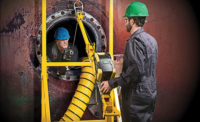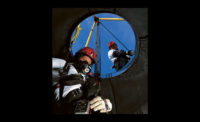We have all read the articles or posts on the questions regarding confined spaces such as “What is a confined space?” or “What makes your confined space permit required?” You might have even been asked “How do you re-classify a permit-required confined space?” or one of my favorites, “When do I need a rescue team at my confined space?” Let’s break it all down.
What is a confined space?
A confined space according to OSHA is a space that is large enough for an employee to bodily enter and perform work AND has limited or restricted means of entry or exit AND is not designed for continuous human occupancy.
We have all heard this, read this, and been told this, but what really does it mean? It is any tank, vessel, silo, storage bin, hopper, vault, pit, manhole, duct, crawl space, pipe, or void that is not supposed to have a person inside it. This simple definition does not say anything about toxic atmospheres or engulfment hazards or anything else that could be dangerous and only states what a confined space is. In reality, it can be brand new; it may never have had anything stored inside; it might hold drinking water or even be completely empty and yet still be classified as a confined space. Having a hazardous atmosphere inside of the confined space is irrelevant at this point of the evaluation.
After identifying the confined space, we need to assess whether or not the space is permit required or non-permit required. “What makes your confined space permit required?”
Your confined space becomes permit required IF: it contains or has the potential to contain a hazardous atmosphere; OR, it contains a material that has the potential for engulfing an entrant; OR, it has an internal configuration that could cause an entrant to become trapped or asphyxiated; OR, it contains any other recognized serious safety and health hazard.
If ANY of those four items listed above occur and your confined space is now permit required!
I can tell you from experience that the majority of confined spaces are permit required simply because the space contains or has the potential to contain a hazardous atmosphere. The key words to note are contains and potential.
Contains means that it is present, it is in there, you know it is there. The potential means that there is a possibility it can be in there or it could show up after. The other statement, contains any other recognized safety and health hazard, also changes many normal confined spaces to be permit required. The reason is that the activity performed inside the space such as chemical cleaning, degreasing, solvents, epoxies, hot work and other tasks all create hazards themselves. Fire hazards, explosions, dust, extreme temperatures, slips and falls, and machinery also increase your safety and health exposures.
How do we re-classify a permit- required confined space?
In order to re-classify the permit-required confined space to a non-permit confined space, employers must ensure that the space does not contain or, with respect to atmospheric hazards, have the potential to contain ANY hazard capable of causing death or serious physical harm.
The ability for an employer to re-classify a permit-required confined space is very difficult, although not impossible. If you look at the definitions of non-permit and permit required, the non-permit space has eliminated, removed and ensured that there are NO hazards present. In my professional opinion, this is very difficult to prove. OSHA takes this one step further and states in the code that in order to reclassify a permit space the space must pose no actual or potential atmospheric hazards and that all hazards within the space can be eliminated without making entry. It even mentions in a foot note that “control of atmospheric hazards through forced air ventilation does not constitute elimination of the hazards.”
A second requirement is that of a written certificate stating the date, the location of the space and the signature of the person making the determination that the space is to be reclassified. This certificate shall be made available to all entrants or their designated representatives. The lack of a reclassified space certificate is by far the biggest violation that I personally observe, but in no way should take away from the fact that confined spaces are not properly reclassified to start.
So now the real question… is it possible to reclassify a permit-required confined space? Yes, but it is very difficult and I believe the instances are few.
When do I need a rescue team at my confined space?
After figuring out all of the basics, rescue comes in to play. Rescue should first be addressed in the required permit-required confined space written program. It is here that employees are given the details and requirements of the OSHA standard and also the company-specific requirements for working in or around confined spaces.
Rescue must also be addressed as to whether it will be a self-rescue, assisted rescue or entry rescue. OSHA also makes it very clear that entrants should self-rescue if they detect a problem or prohibited condition or even if directed to leave. It is also very clear that a mechanical retrieval device is required for entrants in permit required confined spaces that are deeper than five feet vertically. If employees are aggressively monitoring and working a confined space correctly, the employee should receive ample notice as to when they must exit the space. This is self-rescue. If the entrant is hooked up to a mechanical retrieval device and something goes wrong, the attendant can retrieve them from the space. This is assisted rescue.
The final option and last resort is where something catastrophic has occurred and a rescue team must make a physical entry in order to retrieve the entrant. This is a “Go Rescue” or “Entry Rescue.” A Go Rescue must be a last effort as it is a very dangerous activity requiring extensive training, practice and equipment.
The best chance of survival
I teach and also believe that there are five life safety principles that will offer the entrant the best chance of survival while working in a confined space.
- First, continuous air monitoring should be performed in all confined spaces. We cannot determine a change in atmosphere if we are not monitoring continuously.
- Second, all entrants into a confined space must be hooked to a mechanical advantage retrieval system at all times. When something goes bad, no one has the ability to magically attach the retrieval device to a downed entrant.
- Third, fresh air should be provided in all confined space entries and that supply needs to be monitored to ensure it is safe. Simply creating a positive pressure atmosphere in the confined space can help keep contaminants from creating a problem.
- Fourth, all entrants should have with them an emergency escape air bottle to allow them the ability to self-rescue AND have the time to do such by the provided breathing air. These simple devices can be five or ten minute air bottles that simply deploy with a bag that is pulled over the entrant’s head and provides fresh breathing air.
- Lastly, if all confined spaces had a permit filled out correctly, even when not required it would help address possible hazards and also alert the attendant to upcoming hazards. No one likes paperwork and this is one time that dislike should not apply. A permit should always be filled out since it is a true checks and balance approach to safety. It documents what you did and are currently doing. Use it as a checklist to ensure that you covered everything correctly and did not miss something.
Confined spaces can be very dangerous work areas and sadly, employees are not trained to even recognize the hazards. Employers must do their part and educate employees on the hazards of their work, BUT also make every attempt to remove the hazards BEFORE exposing workers to them.
Confined space work does not have to be as hazardous as we tend to make it as long as there is purposeful thought into what, how, when and why. No one wants to have an injury to an employee or worse yet, a fatality, so we all need to do a better job and implement preventive measures when working in or around confined spaces. Be safe always!



